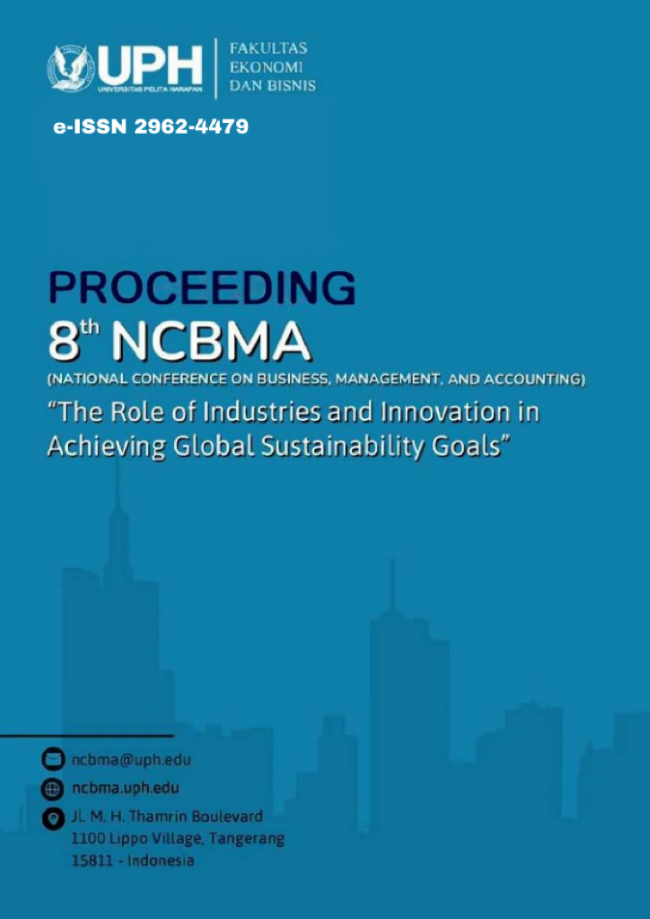THE ROLE OF GROWTH OPPORTUNITIES IN SHAPING CAPITAL STRUCTURE: A COMPARATIVE ANALYSIS OF REAL ESTATE COMPANIES
Kata Kunci:
Capital Structure, Real Estate Companies, Growth Opportunities, Asset Tangibility, Property Development, LeverageAbstrak
This study examines how growth opportunities influence capital structure decisions within the real estate sector through the lens of Trade-off and Pecking Order Theory. Using panel data from 58 publicly listed real estate companies (2019-2023), we investigate how growth opportunities affect the relationship between leverage and four determinants: profitability, liquidity, asset tangibility, and tax shield. By segmenting firms into high, medium, and low growth categories, our analysis reveals that profitability negatively affects leverage in both medium and high-growth firms, with stronger effects in high-growth firms, supporting Pecking Order Theory in environments of heightened information asymmetry. Asset tangibility shows a significant negative relationship exclusively in medium-growth firms, reflecting how inventory and land banks serve as potential collateral, though their effectiveness is dampened by information asymmetry in high and low-growth segments. Liquidity demonstrates a significant negative relationship in both high and medium-growth segments, with stronger effects in high-growth firms, while tax shield effects are insignificant across all categories. These findings contribute to capital structure literature by demonstrating how growth opportunities systematically alter traditional capital structure determinants in the real estate sector, offering important implications for corporate financial management.
Referensi
Diamond, D., Hu, Y., & Rajan, R. (2017). Pledgeability, industry liquidity, and financing cycles. National Bureau of Economic Research Working Paper Series. https://doi.org/10.3386/W23055
Fischer, E. O., Heinkel, R., & Zechner, J. (1989). Dynamic capital structure choice: Theory and tests. The Journal of Finance, 44(1), 19-40.
Frank, M. Z., & Goyal, V. K. (2003). Testing the pecking order theory of capital structure. Journal of Financial Economics, 67(2), 217-248.
Graham, J. R. (2003). Taxes and corporate finance: A review. Review of Financial Studies, 16(4), 1075-1129.
Graham, J. R., & Leary, M. T. (2011). A review of empirical capital structure research and directions for the future. Annual Review of Financial Economics, 3(1), 309-345.
Jensen, M. C. (1986). Agency costs of free cash flow, corporate finance, and takeovers. The American Economic Review, 76(2), 323-329.
Lemmon, M. L., & Zender, J. F. (2007). The pecking order theory and the firm's life cycle. Journal of Financial Economics, 86(3), 515-542.
McConnell, J. J., & Servaes, H. (1995). Equity ownership and the two faces of debt. Journal of Financial Economics, 39(1), 131-157.
Miglo, A. (2011). The pecking order, trade-off, signaling, and market-timing theories of capital structure: A review. In H. K. Baker & G. S. Martin (Eds.), Capital Structure and Corporate Financing Decisions: Theory, Evidence, and Practice (pp. 171-191). John Wiley & Sons.
Modigliani, F., & Miller, M. H. (1963). Corporate income taxes and the cost of capital: A correction. The American Economic Review, 53(3), 433-443.
Myers, S. C. (1984). The capital structure puzzle. The Journal of Finance, 39(3), 575-592.
Myers, S. C., & Majluf, N. S. (1984). Corporate financing and investment decisions when firms have information that investors do not have. Journal of Financial Economics, 13(2), 187-221.
Oliveira, R. L., & Kayo, E. K. (2019). Leverage and investment opportunities: The effect on high growth firms. Revista Contabilidade & Finanças, 31(83), 302-317.
Ozkan, A. (2001). Determinants of capital structure and adjustment to long run target: Evidence from UK company panel data. Journal of Business Finance & Accounting, 28(1‐2), 175-198.
Rajan, R. G., & Zingales, L. (1995). What do we know about capital structure? Some evidence from international data. The Journal of Finance, 50(5), 1421-1460.
Titman, S., & Wessels, R. (1988). The determinants of capital structure choice. The Journal of Finance, 43(1), 1-19.


